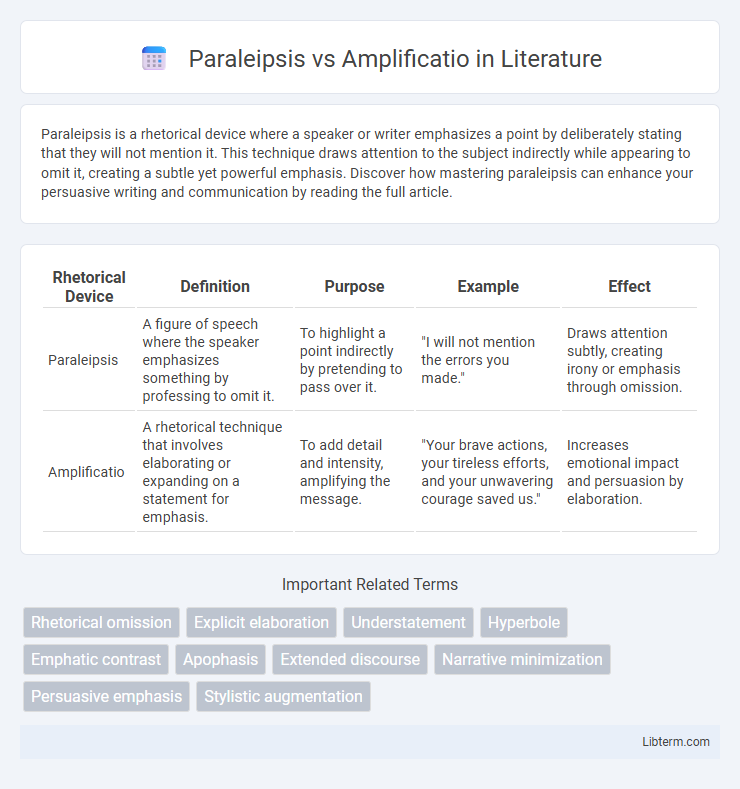Paraleipsis is a rhetorical device where a speaker or writer emphasizes a point by deliberately stating that they will not mention it. This technique draws attention to the subject indirectly while appearing to omit it, creating a subtle yet powerful emphasis. Discover how mastering paraleipsis can enhance your persuasive writing and communication by reading the full article.
Table of Comparison
| Rhetorical Device | Definition | Purpose | Example | Effect |
|---|---|---|---|---|
| Paraleipsis | A figure of speech where the speaker emphasizes something by professing to omit it. | To highlight a point indirectly by pretending to pass over it. | "I will not mention the errors you made." | Draws attention subtly, creating irony or emphasis through omission. |
| Amplificatio | A rhetorical technique that involves elaborating or expanding on a statement for emphasis. | To add detail and intensity, amplifying the message. | "Your brave actions, your tireless efforts, and your unwavering courage saved us." | Increases emotional impact and persuasion by elaboration. |
Introduction to Paraleipsis and Amplificatio
Paraleipsis is a rhetorical device where the speaker highlights a point by pretending to omit it, effectively drawing attention through deliberate omission. Amplificatio involves expanding or elaborating a statement to emphasize its importance or evoke stronger emotions. Both techniques serve to enhance persuasion by manipulating focus and intensity in communication.
Defining Paraleipsis: The Art of Omission
Paraleipsis is a rhetorical device that emphasizes a point by deliberately withholding details, allowing the speaker to draw attention to what is left unsaid while seeming to omit it. This technique creates a powerful effect by hinting at information indirectly, engaging listeners' curiosity and prompting inference. In contrast, amplificatio involves expanding on a statement with additional detail or repetition to enhance its impact.
Understanding Amplificatio: The Technique of Expansion
Amplificatio is a rhetorical technique that involves the deliberate expansion or elaboration of a statement to emphasize its importance, enhancing the emotional impact and clarity for the audience. Unlike paraleipsis, which draws attention to something by pretending to omit it, amplificatio magnifies a point by adding detail, repetition, or exaggeration. This method deepens the listener's or reader's engagement by intensifying the expression of ideas, making arguments more persuasive and memorable.
Historical Origins in Rhetoric
Paraleipsis and amplificatio originate from classical rhetoric, with roots tracing back to ancient Greek and Roman orators like Cicero and Quintilian. Paraleipsis involves deliberately omitting a point to emphasize it indirectly, while amplificatio focuses on expanding and elaborating arguments for stronger persuasive impact. These techniques were fundamental in shaping rhetorical strategies used in political speeches and legal discourses throughout antiquity.
Key Differences Between Paraleipsis and Amplificatio
Paraleipsis involves emphasizing a point by deliberately stating that it will not be mentioned, creating attention through omission, whereas Amplificatio enhances or expands the detail and intensity of a statement to increase its impact. Paraleipsis relies on strategic restraint to highlight a subject indirectly, while Amplificatio uses elaboration and repetition to magnify the significance of an idea. The key difference lies in Paraleipsis drawing focus by pretending to ignore information, whereas Amplificatio focuses on intensifying communication through added description and emphasis.
Functions and Effects in Persuasive Writing
Paraleipsis functions by deliberately highlighting a point through the pretense of omission, creating emphasis and drawing the reader's attention while feigning restraint. Amplificatio extends the message by elaborating details or repeating ideas to intensify emotional impact and reinforce the argument's significance. Both techniques enhance persuasive writing by manipulating focus and depth, ultimately increasing rhetorical effectiveness and audience engagement.
Examples of Paraleipsis in Literature and Speech
Paraleipsis, a rhetorical device where the speaker emphasizes a point by professing to ignore it, appears frequently in literature and speeches, such as Shakespeare's "Julius Caesar," where Antony repeats "I come to bury Caesar, not to praise him" while subtly praising him. Another classic example is in Lincoln's Gettysburg Address, stating, "The brave men, living and dead, who struggled here, have consecrated it," highlighting sacrifice by apparent understatement. Paraleipsis strategically draws attention through omission, contrasting with amplificatio, which expands and intensifies detail.
Illustrative Uses of Amplificatio in Texts
Amplificatio serves to expand and intensify a statement by providing detailed examples, vivid descriptions, or emotional appeals, thereby enhancing the rhetorical impact in texts. It is commonly employed in speeches and literature to emphasize key points, clarify complex ideas, and engage the audience more deeply through elaboration. Unlike paraleipsis, which draws attention by pretending to omit, amplificatio actively develops and magnifies content for persuasive and illustrative purposes.
Choosing the Right Technique: Contexts and Considerations
Paraleipsis emphasizes what is deliberately omitted or ignored to draw attention indirectly, making it effective in contexts requiring subtlety or irony. Amplificatio, which involves elaborating or exaggerating details, works best when the goal is to intensify emotion or highlight importance through vivid description. Selecting between these rhetorical techniques depends on the speaker's intent, audience perception, and the desired impact on message clarity and persuasion.
Conclusion: Impact on Rhetorical Effectiveness
Paraleipsis and amplificatio uniquely shape rhetorical effectiveness through their contrasting approaches: paraleipsis subtly emphasizes a point by feigning omission, creating intrigue and persuasive undercurrents, while amplificatio intensifies a message by elaboration, heightening emotional impact and clarity. The strategic use of paraleipsis can engage the audience's curiosity and imply significance indirectly, making the argument feel more credible and nuanced. Amplificatio's expansion of ideas ensures the audience fully grasps the importance, fostering strong conviction and memorable communication.
Paraleipsis Infographic

 libterm.com
libterm.com